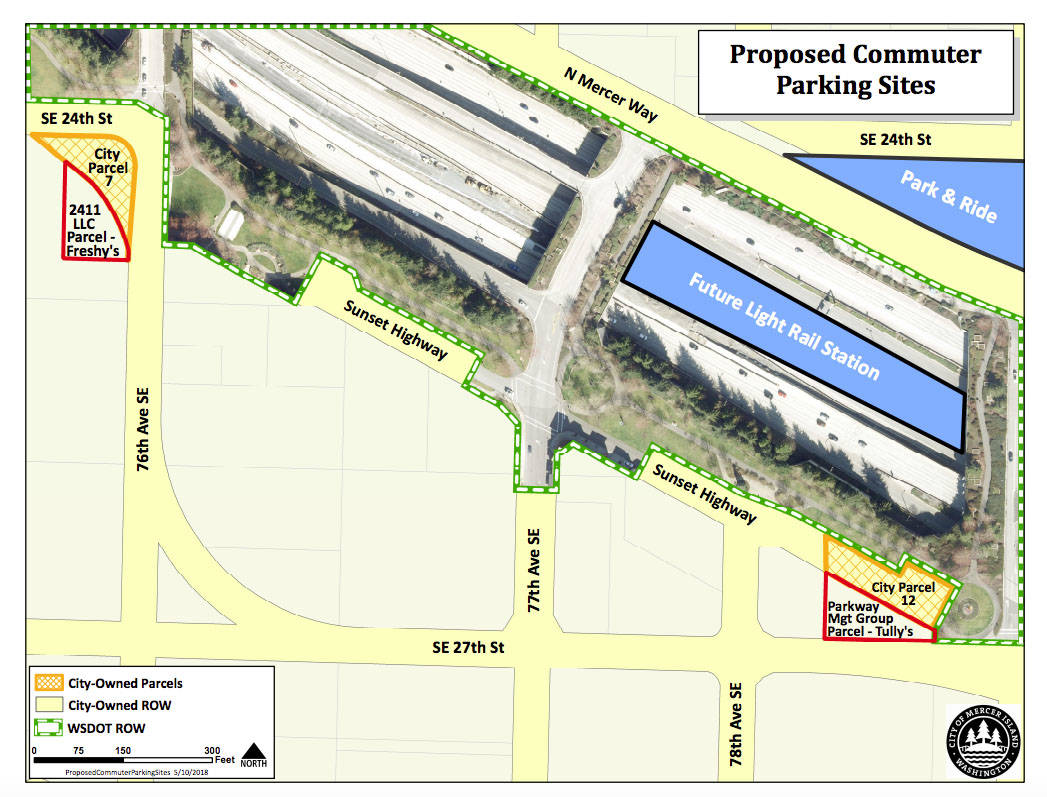The city of Mercer Island announced last week on July 10 that one of two proposed sites for parking stalls, intended to provide an alternative to the swollen 447-stall Park and Ride structure (at 8000 N. Mercer Way) in advance of expanded East Link service, will be abandoned.
Exploration into the construction of underground parking stalls at a small parcel adjacent to the old Freshy’s Seafood Market at the southwest corner of Southeast 24th Street and 76th Avenue Southeast was terminated as the private developer determined that it could not finance the development under the present agreement.
In May of last year, the Freshy’s site developer (Twenty Four Eleven LLC) was set to purchase a city-owned parcel adjacent to a lot already in its possession for $2.3 million, in the understanding that it would then consolidate the two lots, redevelop the space and allocate for roughly 70 parking stalls. Leon Cohen of Twenty Four Eleven LLC said that the terms of the agreement were “unfeasible,” but that Twenty Four Eleven LLC will be approaching the city in the future in the hopes of establishing a new agreement for Islander parking.
With the Twenty Four Eleven site no longer in consideration at this time, the only proposed site is for an underground parking structure near the former Tully’s Coffee at 7810 Southeast 27th Street, which would offer a mixed commercial/residential development above. Together, the Twenty Four Eleven and Tully’s proposals would have accounted for about 200 new parking stalls. With just the Tully’s site in consideration, total new parking stalls would number a few more than 100. It remains unclear whether, in the absence of a second site, the number of stalls featured in the Tully’s design will change.
“At this point, the city is going to maintain its prime focus on the Tully’s property and allocate as much time and energy toward making that one succeed as possible,” city sustainability and communications manager Ross Freeman said. “You never know if another property might come up, but there aren’t that many properties close to the light rail station that have uncertain futures. It’s mostly built out, or it’s DOT (Department of Transportation) land, or it’s a street — so there’s not that many places where this can happen again, as things stand right now.”
According to Freeman, some developers had loosely configured a performance space for Mercer Island Center for the Arts (MICA) into their designs at the project’s outset, knowing that doing so would make for a more attractive pitch to the city. Now, with just one proposed site split between two developers (Mainstreet Property Group and Sheldon Holdings/Weinstein A+U), MICA has begun to take seriously the idea of having venue space above the Tully’s site. Freeman acknowledged that discussions between MICA and the developers have taken place, but that the city has not been privy to them.
Roundabout acquisition
In other transit news, Sound Transit spokesperson Rahcelle Cunningham said that the acquisition process for the two properties near the future 77th Street roundabout site is underway.
“We’re going to be issuing a final design contract in the next month so that we can just keep moving forward with this. It’s a pretty tight timeline to be able to get it completed by the time East Link begins operation,” Cunningham said. “Construction at this point is supposed to begin in 2021, so we need to get from 30 percent all the way up to 90 percent design before that can happen.”
While the light rail work pushes ahead, King County Metro, which was not a party in the city’s settlement agreement with Sound Transit, continues to brief city officials on how bus service on the Island can be adjusted around light rail expansion. In an email response, Metro service planning supervisor Kate Chalmers addressed one of the service provider’s chief challenges.
“As with any facility where bus routes begin or end, having space for bus layover is a critical consideration. Bus layover is space where buses can park between trips while operators get a break. Layover time is needed for these breaks but also to provide time between trips to allow buses to get back on schedule if prior trips run late,” she wrote. “The main limitation for Metro at the Mercer Island transit interchange will be the amount of layover space available, which limits the frequency of trips that can connect to Link light rail from another place.”
EDITOR’S NOTE: The name of the former business Freshy’s was corrected in this story. An earlier version of this story spelled Twenty Four Eleven LLC numerically and did not include Leon Cohen’s comment.



